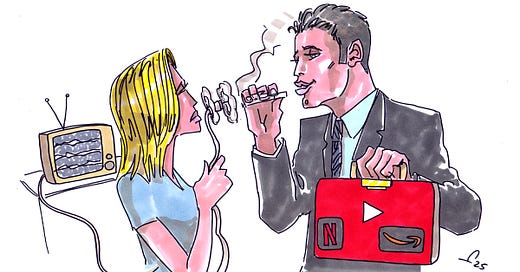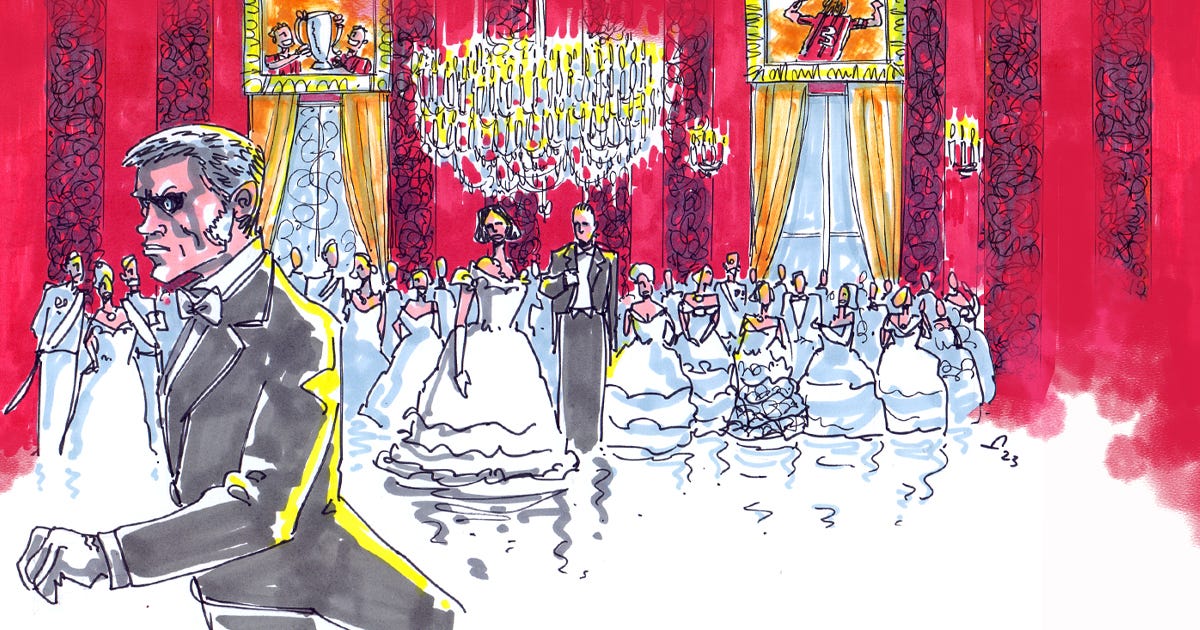Papa’s got a brand new bag.
Let’s cut the crap and call it for what it is. The share of digital eyeballs owned and reachable by old broadcasters and Sport PayTV is reaching a tipping point of irrelevance.
The Albachiara Journal is an eclectic collection of our opinion and perspective, from our travels and encounters.
The return of the Sunday Column last week was part of a TTMYGH five-essay compendium about Fourth Turnings, called Fin de Siècle.
“Fin de siècle” is a French term meaning “end of century”, a phrase which typically encompasses both the meaning of the similar English idiom, turn of the century, and also makes reference to the closing of one era and onset of another. Changes which are actually taking place at these junctures tend to acquire extra (sometimes mystical) layers of meaning.
Wikipedia
These days, one really struggles to not fall into the “end-of-days” melodrama that is so easily provoked by events all around us, in popular culture, finance, business, religion and politics.The evening news bulletins look like scenes from The Matrix.
Il Gattopardo, a previous Column, talked about another such moment of intense change, in Sicily at the time of Italy’s unification, linking to the decaying state of Italian and European football.
Paolo Maldini, Il Gattopardo – Albachiara Journal
The Fourth Turning in sport in these last two years has since picked up pace, and this alacrity of change brings our industry to a really important Face-Off.
It is today’s Sunday Column.
Sport’s Fin de Siècle?
When I first formally joined this sector in 1998, we were 6 years into the new dynamics surrounding the business of sport. In reality, the English Premier League (EPL) in 1992 kick-started this new professional era, where the revenues accruing to local football/sports teams would no longer be dominated by match-day ticket sales, but by media rights values for live game coverage.
My own Scottish Premier League (SPL) in 1998 had just penned a similar deal (with BSkyB) when I impulsively decided to become its founding CEO. The analogue music business, and its physical CD, was dying, so sport’s new paradigm came along at just the right time to offer me the last chopper out of Saigon for my career in IP.
Perhaps without it knowing, or caring, sport would in fact become the key differentiator in the battle to dominate the emerging Pay/Cable TV media industry, as fans/customers bought subscriptions to the broadcast provider who had exclusive live coverage of their favourite games and competitions.
A new era was born, that would change everything.
To that point, the elite end of European football had been dominated by the big passionate working-class cities like my own Glasgow, which had two genuinely competitive franchises in Celtic and Rangers, both regulars at the sharp end of UEFA tournaments. This all made for a pretty level playing field in traditional football across the Continent. Many different names appeared unpredictably in Cups; Aberdeen, Derby, Sampdoria, St. Etienne, Valencia, Panathinaikos, Red Star.
When instead broadcast revenues started to reward mainly the leagues with big TV markets, it began a true re-ordering of the entire football food-chain. A big club from a country that could offer only small numbers of PayTV subscribers (Ajax and Holland, Benfica and Portugal), got financially blown out of the water by small clubs from the Big 5 leagues of England, Germany, Spain, Italy and France. Names like Bournemouth, PSG, Brighton, Atalanta, Fulham come to mind. These types of clubs, with all due respect, should be nowhere near the sharp end of elite football, but their fulsome media revenues have now also attracted new outside capital, further accelerating the polarisation and imbalance of it all. When was the last time a team from outside the Big 5 leagues won the Champions league?
So it is not hyperbole to say that the growth of broadcast revenues in these 30 years has utterly changed European football. Maybe for the better, but, for many of us, it has been a painful death of a thousand cuts, in a slide into also-ran mediocrity. Humiliating even. Younger fans, who didn’t see the glory days, feel it less, and that war has been long lost.
For 30 years, across all sports, we have seen this unrelenting trend-line of exponential revenue growth from ever-increasing media values. You had the odd blip, like the media recession post the dot.com bust and 9/11, but these can hardly be seen in the 30 year chart.
Up-and-to-the-right was the mantra.
It was the trope that became so unchallenged as to lead to some of our industry’s most embarrassing investments, by both private equity funds and broadcasters. No one thought rights could ever go down, but, with hindsight, they were just perfectly correlated to the health of the exceptionally high-margin business called subscription linear TV. Many are now learning that strong correlation works both ways, and spotting it early is the cornerstone of all top capital allocation and investment.
Once the bundle was unpicked, the carnage was actually inevitable. For example, Comcast, the listed parent company of Sky and NBC/Peacock, had a recent very depressing earnings call, as this post on Linkedin explains.
Fin de Siècle.
To continue reading this article, and discover how a pro thinks, please click here.
Embark on a gripping journey through the intertwined worlds of sports, media, and finance in "Sport's Perfect Storm."
Authored by Roger Mitchell, this illuminating book unveils the challenges these industries face amidst a hurricane of change. Learn how to navigate the turbulent seas of uncertainty, ensuring not just survival but sustainable success.
This book is recommended reading for those starting out, as well as also being a serious manual for experienced corporate finance people, especially those looking to invest in sport.
To secure your Limited Edition copy now, unveil hidden risks, and sail towards a future of informed decision-making, click below 👇






